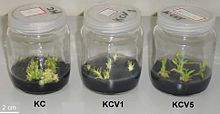Vinasse
Vinasseis abyproductof thesugarorethanolindustry.[1]Sugarcaneorsugar beetis processed to producecrystallinesugar,pulp andmolasses.The latter are further processed byfermentationtoethanol,ascorbic acidor other products. Juice sugarcane can also be processed directly by ethanol fermentation. After the removal of the desiredproduct(alcohol,ascorbic acid,etc.) the remaining material is called vinasse. Vinasse is sold after a partialdehydrationand usually has aviscositycomparable tomolasses.Commercially offered vinasse comes either fromsugar caneand is called cane-vinasse or fromsugar beetand is called beet-vinasse. Vinasse produced from sugar cane is also calleddunder.[2]
In the process ofdistillationof the alcohol and as a result of the heating in the distillation process, in the pulp of the beet reactions ofcondensationand predominantly molecular ruptures take place. This causes a highfulvic acidconcentration in this byproduct. One use of vinasse is inthermophilic digesters.InBrazil,thermophilic digestionis a source ofbiogasusing pure and hot vinasse as the source of production of methane. In the past, vinasse was a problem in production ofethanol,but vinasse is also a goodfertilizer(at least for some time) and a source ofmethanethat can be used to generate heat or electricity. Moreover, other uses of vinasse involving also the formulation of nutritive solutions for hydroponics,[3]formulation of culture media for plant tissue culture[4]and culture media for algal growth.[5][6]

See also
[edit]References
[edit]- ^Hidalgo, K. (2009) Vinasse infeed:Good for animal and environment. Feed Tech, 13(5):18-20.
- ^Muspratt, Sheridan; Horsford, Eben Norton (1860).Chemistry, Theoretical, Practical, and Analytical: As Applied and Relating to the Arts and Manufactures.W. Mackenzie. pp.107.Retrieved27 February2012.
dunder.
- ^Santos, J. D. et al (2013) Development of a vinasse nutritive solutions for hydroponics. Journal of Environmental Management 114: 8-12.
- ^Silva, A. L. L. et al (2014) Development of a vinasse culture medium for plant tissue culture. Pakistan Journal of Botany 46 (6): 2195-2202.
- ^Gollo, A. L. et al (2016) Developing a plant culture medium composed of vinasse originating fromHaematococcus pluvialisculture. Pakistan Journal of Botany 48 (1): 295-303.
- ^Colusse, Guilherme Augusto; Santos, André Oliveira; Rodrigues, Jenifer Mota; Barga, Marcelo Calide; Duarte, Maria Eugênia Rabello; de Carvalho, Júlio Cesar; Noseda, Miguel Daniel (2021-07-01)."Rice vinasse treatment by immobilized Synechococcus pevalekii and its effect on Dunaliella salina cultivation".Bioprocess and Biosystems Engineering.44(7): 1477–1490.doi:10.1007/s00449-021-02531-9.ISSN1615-7605.
Further reading
[edit]- Tejada, M., Gonzalez, J.L., 2006.Effects of two beet vinasse forms on soil physical properties and soil loss.Catena 68, 41–50
